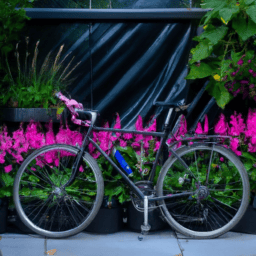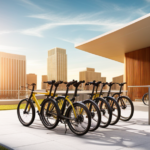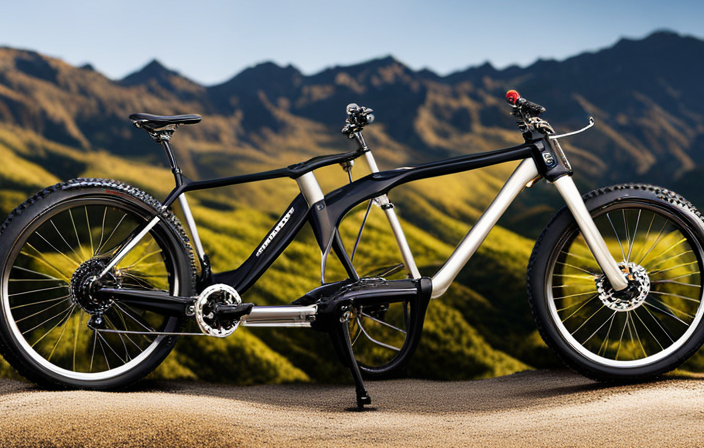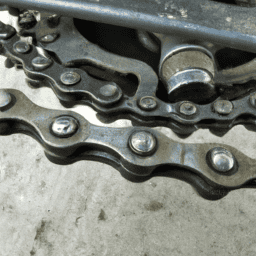Ever thought about how to keep your bike outdoors without it being damaged by weather or stolen? Speaking from years of cycling experience, I can assert that appropriate storage is essential for maintaining your bicycle’s condition and safeguarding it against theft.
When it comes to storing your bike outside, there are a few key factors to consider. First and foremost, you want to choose a secure location that is less likely to attract thieves. You also need to invest in a quality lock and remove any valuables or accessories that could be easily taken.
And finally, you need to regularly maintain and clean your bike to ensure it stays in good condition. In this article, I will walk you through these steps and provide additional tips for storing your bicycle outside.
Key Takeaways
- Choose a secure location that is less likely to attract thieves and is not too visible from the street or sidewalk.
- Invest in anti-theft measures such as a quality lock and remove valuable accessories before leaving the bike unattended.
- Protect the bike from the elements with a bike cover and schedule regular maintenance checks to catch any issues early on.
- Consider alternative storage options such as vertical racks, wall mounts, or ceiling hoists to save space.
Choose a Secure Location
You’ll want to find a spot that’s not too visible from the street or sidewalk and that’s covered enough to protect your bike from rain and sun. Look for a location that’s sheltered by a tree or a building, and make sure it’s not too close to the road or a pedestrian walkway. This will make it harder for thieves to spot your bike and steal it.
Weather protection is important when storing your bicycle outside. Exposure to rain, snow, and sun can cause damage to your bike’s frame, tires, and other components. Make sure the location you choose provides adequate protection from the elements.
Additionally, consider investing in anti-theft measures such as a quality lock to deter any would-be thieves. With these precautions, you can help ensure your bike stays safe and secure.
Invest in a Quality Lock
Investing in a quality lock can ensure your two-wheeled mode of transportation stays safe from potential theft. As someone who’s had a bike stolen before, I know the importance of having a lock that can keep it secure.
When choosing a lock, look for one that’s made of high-quality materials and has a secure locking mechanism. A U-lock or chain lock are popular options that can provide a strong deterrent to thieves.
It’s not just enough to have a good lock, though. Proper lock maintenance and locking techniques are also important to ensure the safety of your bike. Make sure to regularly oil the lock to prevent it from getting stuck or jammed.
When locking your bike, secure both wheels and the frame to a sturdy object, such as a bike rack or sturdy pole. Additionally, try to lock your bike in a well-lit and visible area to deter potential thieves.
By investing in a quality lock and following proper locking techniques, you can help prevent your bike from being stolen and keep it safe outdoors. And speaking of safety, the next step is to remove any valuable accessories from your bike before storing it outside.
Remove Valuables and Accessories
Make sure to take off any valuable accessories from your bike before leaving it unattended, as they can easily be stolen and compromise the safety of your ride. This includes anything from lights, water bottles, and GPS devices to quick release seats and wheels. It may seem inconvenient, but taking the extra time to remove these items can save you from the hassle of replacing them later on.
Plus, it reduces the likelihood of your bike being targeted by thieves. In addition to removing valuables, it’s also important to secure your bike’s wheels and cover its frame. Securing the wheels can be done through the use of a wheel lock or by removing them and storing them separately from the bike.
As for covering the frame, there are a variety of options ranging from simple bike covers to more heavy-duty tarps. Keeping your bike covered not only protects it from potential damage, but it also makes it less noticeable to potential thieves. By taking these precautions, you can ensure your bike remains safe and secure even when stored outside.
Now, let’s move on to the next step of regular maintenance and cleaning.
Regular Maintenance and Cleaning
Caring for your bike is like nurturing a garden, requiring regular attention and maintenance to keep it in top condition.
One of the most important things to do is to clean it regularly. This not only keeps the bike looking good, but it also helps to prevent rust and other damage. When choosing cleaning products, be sure to use ones that are specifically designed for bikes. Avoid using harsh chemicals that can damage the paint or other components.
In addition to cleaning, it’s also important to schedule regular maintenance checks. This can help to catch any issues early on, before they become more serious problems. Some things to check include the brakes, tires, and gears. You may want to consider taking your bike to a professional for a tune-up once a year.
With proper maintenance and cleaning, your bike will be in great shape for years to come. As you consider alternative storage options, it’s important to remember that regular maintenance is still necessary to keep your bike in top condition.
Consider Alternative Storage Options
If you’re short on space, it’s worth exploring different ways to keep your bike safe and accessible. Here are a few alternative storage options that you may want to consider:
-
Bike covers: These are designed to protect your bike from the elements and can be used to store your bike outside without worrying about it getting damaged. They come in different sizes and materials, so make sure to choose one that fits your bike and your needs.
-
Vertical racks: These are a great option if you have limited floor space. They allow you to store your bike vertically, which saves space and keeps your bike out of the way. Make sure to choose a rack that is sturdy and can hold the weight of your bike.
-
Wall mounts: These allow you to hang your bike on the wall, which can also save floor space. They come in different styles and materials, so choose one that matches your decor and can hold the weight of your bike.
-
Ceiling hoists: These are a good option if you have high ceilings and want to keep your bike out of the way. They allow you to suspend your bike from the ceiling, which can save space. Make sure to choose a hoist that is easy to use and can hold the weight of your bike.
Overall, there are many different ways to store your bike outside, even if you have limited space. By exploring these alternative storage options, you can find a solution that works best for you and your bike.
Frequently Asked Questions
Can I use a tarp to cover my bike if I don’t have a garage or shed?
Yes, if you don’t have a garage or shed, you can use waterproof covers instead of a tarp to protect your bike from the elements. Tarp alternatives include bike covers and storage tents.
Is it okay to store my bike outside in extreme weather conditions?
I never leave my bike outside in extreme weather. But if I had to, I’d use a weather-resistant bike cover and store it in a dry, sheltered area with proper ventilation. Regular cleaning and maintenance are also crucial for bike longevity.
How often should I grease my bike’s chain to prevent rust?
I usually grease my bike chain every 100-200 miles or after wet rides. Proper lubrication techniques include applying a small amount of lubricant to each link and wiping off excess. Chain cleaning methods involve using a chain cleaner tool or degreaser and a brush.
What can I do to prevent my bike from being stolen besides using a lock?
To prevent bike theft, I use multiple locks and remove any easily removable parts. I also park it in a well-lit area with high foot traffic. As an alternative storage method, I bring my bike indoors when possible.
Are there any specific types of outdoor bike covers that are better than others?
When choosing an outdoor bike cover, consider the pros and cons of waterproof vs breathable covers. Different sizes and shapes are available, so choose one that fits your bike properly.
Conclusion
Overall, storing a bicycle outside requires some thought and effort to ensure it stays safe and in good condition. As someone who’s had their fair share of stolen bikes, I can attest to the importance of choosing a secure location and investing in a quality lock.
It’s also important to remove any valuables or accessories that could attract thieves. Regular maintenance and cleaning can also go a long way in keeping your bike in good shape. This includes basic tasks like lubricating the chain and wiping down the frame, as well as more thorough cleanings and inspections as needed.
If you’re unable to store your bike outside due to space or safety concerns, there are alternative storage options to consider. From wall-mounted racks to ceiling hoists, there are a variety of products available to help you maximize your storage space and keep your bike safe and secure.
All in all, with a little bit of effort and attention, you can ensure that your outdoor bike storage is both practical and safe.
















